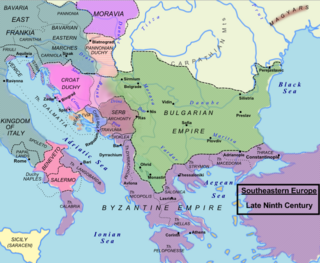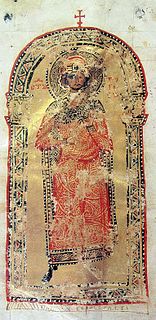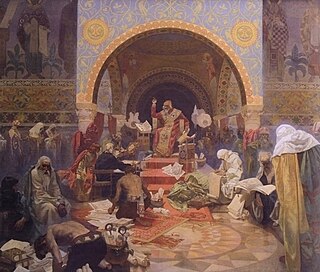
The Bulgars were Turkic semi-nomadic warrior tribes that flourished in the Pontic–Caspian steppe and the Volga region during the 7th century. They became known as nomadic equestrians in the Volga-Ural region, but some researchers say that their ethnic roots can be traced to Central Asia. During their westward migration across the Eurasian steppe, the Bulgar tribes absorbed other ethnic groups and cultural influences in a process of ethnogenesis, including Indo-European, Finno-Ugric and Hunnic tribes. Modern genetic research on Central Asian Turkic people and ethnic groups related to the Bulgars points to an affiliation with Western Eurasian populations. The Bulgars spoke a Turkic language, i.e. Bulgar language of Oghuric branch. They preserved the military titles, organization and customs of Eurasian steppes, as well as pagan shamanism and belief in the sky deity Tangra.
Nicholas I, called Nicholas the Great, was the pope from 24 April 858 until his death. He is remembered as a consolidator of papal authority, exerting decisive influence on the historical development of the papacy and its position among the Christian nations of Western Europe. Nicholas I asserted that the pope should have suzerainty over all Christians, even royalty, in matters of faith and morals.

The Principality of Serbia was one of the early medieval states of the Serbs, located in western regions of Southeastern Europe. It existed from the 8th century up to c. 969-971 and was ruled by the Vlastimirović dynasty. Its first ruler known by name was Višeslav who started ruling around 780. In 822, the Serbs were said to rule the "greater part of Dalmatia", while by that time, starting from the year 681, the Bulgarian state had taken the lands to the east, preparing to conquer Serbia. Vlastimir defeated the Bulgarian army in a three-year-war (839–842), and the two powers lived in peace for some decades. Vlastimir's three sons succeeded in ruling Serbia together, although not for long; Serbia became a key part in the power struggle between the Byzantines and Bulgarians, which also resulted in major dynastic wars for a period of three decades. Central parts of the principality were shortly occupied by the Bulgarian army for three years (924–927), until Serbian prince Časlav was able to liberate the land and unite several Serbian regions, becoming the most powerful ruler of the Vlastimirović dynasty. An important process during this period was the Christianization of the Serbs, the establishment of Christianity as state-religion c. 869, and the founding of the first Serbian eparchy (diocese), the Eparchy of Ras. The principality was annexed by the Byzantines in c. 969-971 and ruled as the Catepanate of Ras. The main information of the history of the principality and Vlastimirović dynasty are recorded in the contemporary historical work De Administrando Imperio.

Boris I, also known as Boris-Mihail (Michael) and Bogoris, was the ruler of the First Bulgarian Empire in 852–889. At the time of his baptism in 864, Boris was named Michael after his godfather, Emperor Michael III. The historian Steven Runciman called him one of the greatest persons in history.
Vladimir-Rasate was the ruler of the First Bulgarian Empire from 889 to 893.

The Madara Rider or Madara Horseman is an early medieval large rock relief carved on the Madara Plateau east of Shumen in northeastern Bulgaria, near the village of Madara. The monument is dated in the very late 7th, or more often very early 8th century, during the reign of Bulgar Khan Tervel. In 1979 became enlisted on the UNESCO World Heritage List.

The Dulo clan was a ruling dynasty of the Bulgars. The origins of the Bulgars and Dulo clan are not known precisely, and there are many theories about their origin. It is generally considered that they - or at least the elite caste - is intimately related to the origin and activity of the Huns and Western Turkic Khaganate. Particularly, it is said that the Dulo descended from the rulers of Great Bulgaria, which was founded by Khan Asparukh's (679–701) father on the steppes of Ukraine. This state was a centralized monarchy from its inception, unlike previous Hunno-Turkic political entities, which were tribal confederations.

The First Bulgarian Empire was a medieval Bulgar-Slavic and later Bulgarian state that existed in Southeastern Europe between the 7th and 11th centuries AD. It was founded in 681 when Bulgar tribes led by Asparuh moved to the northeastern Balkans. There they secured Byzantine recognition of their right to settle south of the Danube by defeating – possibly with the help of local South Slavic tribes – the Byzantine army led by Constantine IV. At the height of its power, Bulgaria spread from the Danube Bend to the Black Sea and from the Dnieper River to the Adriatic Sea.

The Christianization of Bulgaria was the process by which 9th-century medieval Bulgaria converted to Christianity. It reflected the need of unity within the religiously divided Bulgarian state as well as the need for equal acceptance on the international stage in Christian Europe. This process was characterized by the shifting political alliances of Boris I of Bulgaria with the kingdom of the East Franks and with the Byzantine Empire, as well as his diplomatic correspondence with the Pope.

The Photian Schism was a four-year (863–867) schism between the episcopal sees of Rome and Constantinople. The issue centered around the right of the Byzantine Emperor to depose and appoint a patriarch without approval from the papacy.

Vlastimir was the Serbian prince from c. 830 until c. 851. Little is known of his reign. He held Serbia during the growing threat posed by the neighbouring, hitherto peaceful, Bulgarian Khanate, which had expanded significantly toward Serbia.
Mutimir was prince of Serbia from ca. 850 until 891. He defeated the Bulgar army, allied himself with the Byzantine emperor and ruled the first Serbian Principality when the Christianization of the Serbs took place and the Eparchy of Ras was established.

The Christianization of the Rus' people is supposed to have begun in the 860s and was the first stage in the process of Christianization of the East Slavs which continued well into the 11th century. Despite its historical and cultural significance, records detailing the event are hard to come by, and it seems to have been forgotten by the time of Vladimir's Baptism of Kiev in the 980s.

In 9th-century Christianity, Charlemagne was crowned as Holy Roman Emperor, which continued the Photian schism.
Peter was a Bulgarian noble and relative of knyaz (khan) Boris I who was in charge of diplomatic missions during the Christianization of Bulgaria. His position in the Bulgarian administrative hierarchy is unknown but it has been suggested that he had the title kavhan, i. e. the second person in the state after the monarch.
Events from the 9th century in, or regarding, Historic Serbia or Serbs.

Old Great Bulgaria or Great Bulgaria, also often known by the Latin names Magna Bulgaria and Patria Onoguria, was a 7th-century state formed by the Onogur Bulgars on the western Pontic–Caspian steppe. Great Bulgaria was originally centered between the Dniester and lower Volga.

Tsar, also spelled czar, or tzar or csar, is a title used to designate East and South Slavic monarchs or supreme rulers of Eastern Europe, originally the Bulgarian monarchs from 10th century onwards, much later a title for two rulers of the Serbian State, and from 1547 the supreme ruler of the Tsardom of Russia and the Russian Empire. In this last capacity it lends its name to a system of government, tsarist autocracy or tsarism. The term is derived from the Latin word caesar, which was intended to mean "emperor" in the European medieval sense of the term—a ruler with the same rank as a Roman emperor, holding it by the approval of another emperor or a supreme ecclesiastical official —but was usually considered by western Europeans to be equivalent to king, or to be somewhat in between a royal and imperial rank.

The Bulgarian-Serbian War of 839–842 was fought between the Bulgarian Khanate and the Serbian Principality. It was the first conflict of the medieval Bulgarian–Serbian Wars.













